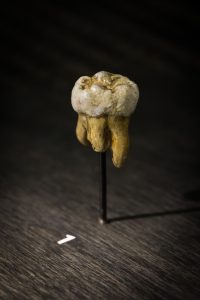By Rachel Cherney
“Where did we come from?” “Why are we here?” These questions have been asked since the dawn of modern humans. While these questions often have a more rhetorical, philosophical meaning, there is also a scientific answer as to how modern humans arose and from where they came. We (Homo Sapiens), are the only remaining species of modern humans. However, 20,000-300,000 years ago, there were many different human species, all originating from a same common ancestor we share with other apes.
The image below left shows the evolution of humans and apes from our common ancestor. The numbers on the side represent how many millions of years ago the species split and evolved. Our common ancestor is in red, and split into modern day gorillas (pink), modern day chimpanzees (purple), ancient humans (dark blue) and more recent humans, including us, current Homo Sapiens (light blue). Next to that image is a zoomed in view of the evolution and intersection of various branches of ancient humans, with sapiens closest to present.
Understanding from where and how humans evolved has been challenging. We rely on bones and artifacts such as tools and jewelry to be able to estimate how many years ago they lived. Additionally, bone fragments are usually small, so we are rarely able to put a skeleton together, but from these bone fragments, scientists are able to take out DNA. The DNA in ancient bones can be compared to one another and to present day human DNA to determine how old the bone is and which human species the bone came from. At one point in time, there were three major species of humans: Modern humans, Neanderthals, and Denisovans. We know much about Neanderthals, and while we know the Denisovans existed, we know little else about them.
In the 1970’s, scientists found archaeological remains in a cave in Siberia, Russia. This cave, called the Denisova Cave, has since become an important resource for finding fossils, and recently, a lost branch of human evolution. A New York Times article reported on the findings, which were published in Nature in January 2019. Recent fossils suggest that the Denisovan occupied this cave for thousands of years. Until the discovery of this cave, it was unknown exactly when the Denisovans lived and how they became extinct. Fossil evidence from the cave, a Denisovian molar (image below), suggests they lived at least in that cave between 45,000 to up to 300,000 years ago!
While we don’t know if they occupied the cave that entire time or they came and went, the intricacy of some of the artifacts suggests they may have had similar mental capacity and sophistication to modern humans, but no evidence of modern humans, Homo sapiens, has been found in the cave. Modern humans lived and traveled in larger groups than Neanderthals or Denisovans, and were able to spread quickly among the continents. Modern humans were estimated to have arrived in Asia ~65,000 years ago.
We are still unsure whether Neandertals and Denisovans died out themselves or were bred out of existence, but since modern Asians and Europeans have bits of Denisovan and Neanderthal DNA respectively, it seems that modern humans, Denisovans and Neandertals interbred at times. In an incredible and recent finding, described in another New York Times article, scientists found bone from a child that had a Neandertal mother and a Denisovan father, a unique and special archaeological artifact. Scientists were able to use mitochondrial DNA from the bone sample, specific DNA in our bodies that we get from our mothers, to determine the parents. Despite interbreeding, the three human species never became one, with only modern humans surviving.
If you are interested in the topic of human evolution from a genetic perspective, read the book “Who We Are and How We Got Here” by David Reich. It is an excellent book, and many of the scientists mentioned in this article are referenced in it.
Edited by Clare Gyorke and Rachel Battaglia


